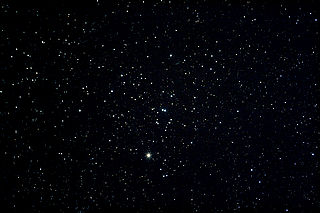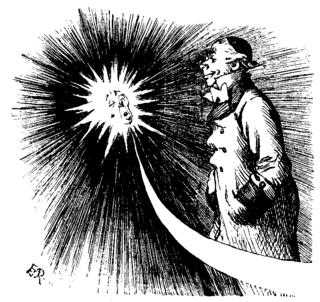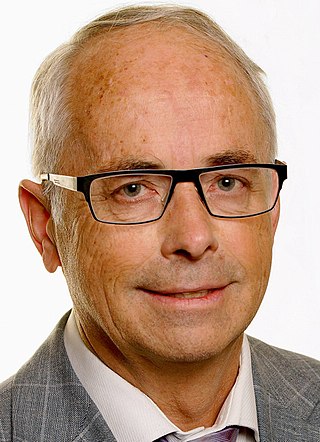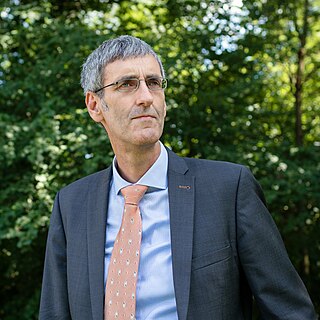Related Research Articles

The Hyades is the nearest open cluster and one of the best-studied star clusters. Located about 153 light-years away from the Sun, it consists of a roughly spherical group of hundreds of stars sharing the same age, place of origin, chemical characteristics, and motion through space. From the perspective of observers on Earth, the Hyades Cluster appears in the constellation Taurus, where its brightest stars form a "V" shape along with the still-brighter Aldebaran. However, Aldebaran is unrelated to the Hyades, as it is located much closer to Earth and merely happens to lie along the same line of sight.

The American Astronomical Society is an American society of professional astronomers and other interested individuals, headquartered in Washington, DC. The primary objective of the AAS is to promote the advancement of astronomy and closely related branches of science, while the secondary purpose includes enhancing astronomy education and providing a political voice for its members through lobbying and grassroots activities. Its current mission is to enhance and share humanity's scientific understanding of the universe as a diverse and inclusive astronomical community.
The SAO/NASA Astrophysics Data System (ADS) is an online database of over 16 million astronomy and physics papers from both peer reviewed and non-peer reviewed sources. Abstracts are available free online for almost all articles, and full scanned articles are available in Graphics Interchange Format (GIF) and Portable Document Format (PDF) for older articles. It was developed by the National Aeronautics and Space Administration (NASA), and is managed by the Smithsonian Astrophysical Observatory.

George Ellery Hale was an American solar astronomer, best known for his discovery of magnetic fields in sunspots, and as the leader or key figure in the planning or construction of several world-leading telescopes; namely, the 40-inch refracting telescope at Yerkes Observatory, 60-inch Hale reflecting telescope at Mount Wilson Observatory, 100-inch Hooker reflecting telescope at Mount Wilson, and the 200-inch Hale reflecting telescope at Palomar Observatory. He also played a key role in the foundation of the International Union for Cooperation in Solar Research and the National Research Council, and in developing the California Institute of Technology into a leading research university.

William Frederick Denning was a British amateur astronomer who achieved considerable success without formal scientific training. He is known for his catalogues of meteor radiants, observations of Jupiter's red spot, and for the discovery of five comets. Outside astronomy, as a young man, Denning showed prowess at cricket to the extent W G Grace invited him to play for Gloucestershire. However Denning’s retiring nature made him decline the offer.

Svein Rosseland was a Norwegian astrophysicist and a pioneer in the field of theoretical astrophysics.
The British Astronomical Association (BAA) was formed in 1890 as a national body to support the UK's amateur astronomers.

The Liverpool Astronomical Society was founded in 1881 in Liverpool, England, as a society to promote and coordinate amateur astronomy.
HD 213429 is a spectroscopic binary system in the equatorial constellation of Aquarius. It has a combined apparent magnitude of 6.16 and is located around 83 light years away. The pair orbit each other with a period of 631 days, at an average separation of 1.74 AU and an eccentricity of 0.38.

Astronomy & Astrophysics is a monthly peer-reviewed scientific journal covering theoretical, observational, and instrumental astronomy and astrophysics. The journal is run by a Board of Directors representing 27 sponsoring countries plus a representative of the European Southern Observatory. The journal is published by EDP Sciences and the editor-in-chief is Thierry Forveille.
Øystein Elgarøy was a Norwegian astronomer, with a specialty in solar radio astronomy.
James Bailey "Jim" Kaler was an American astronomer and science writer.
The Astronomical Society of India (ASI) is an Indian society of professional astronomers and other professionals from related disciplines. It was founded in 1972, with Vainu Bappu being the founder President of the Society, and as of 2010 has a membership of approximately 1000. Its registered office is at the Astronomy Department, Osmania University, Hyderabad, India. Its primary objective is the promotion of Astronomy and related branches of science. It organises meetings, supports and tries to popularise Astronomy and related subjects and publishes the Bulletin of the Astronomical Society of India.
Reginald Lawson Waterfield was a British hematologist known for his work in amateur astronomy, specialising in astrometry and the photography of comets. He was elected to the British Astronomical Association on 25 November 1914 and to the Royal Astronomical Society on 10 November 1916. Both elections being at the proposal of W H Steavenson. Waterfield served as Director of the British Astronomical Association Mars Section from 1931-1942 and its president from 1954–1956. For his work in astronomy he won the 1942 Jackson-Gwilt Medal. After World War II he had to use a wheelchair due to polio. The minor planet 1645 Waterfield is named jointly for him and his cousin William Francis Herschel Waterfield (1886-1933), who was also a member of the British Astronomical Association and Fellow of the Royal Astronomical Society.
Thomas M. Dame is Director of the Radio Telescope Data Center at the Center for Astrophysics | Harvard & Smithsonian, a Senior Radio Astronomer at the Smithsonian Astrophysical Observatory, and a Lecturer on Astronomy at Harvard University. He is best known for mapping the Milky Way galaxy in Carbon Monoxide and for the discovery of both the Far 3 kpc Arm and the Outer Scutum–Centaurus Arm of the Milky Way.

Arnold O. Benz is a professor emeritus at the Institute for Particle Physics and Astrophysics in the Physics Department of ETH Zurich.
The Swedish Astronomical Society a national organization in Sweden aimed at people who want to follow the achievements of astronomical research,. Founded in 1919 on the initiative of astronomer Nils Nordenmark, the society has from the outset aimed to be "an intimate connection between scientists, amateur astronomers and others interested in astronomy" The society runs a program of lectures and other outreach activities, including since 2012 Sweden's annual Day and Night of Astronomy. Since 1920 society has published a quarterly Swedish-language magazine, initially Populär Astronomisk Tidskrift, since 2001 published as Populär Astronomi. The current of the society is astronomer and writer Peter Linde.

Nature Astronomy is a peer reviewed scientific journal published by Nature Portfolio. It was first published in January 2017, although the first content appeared online in December 2016. The editor-in-chief is May Chiao, who is a full-time professional editor employed by the journal. The founding editors of this journal, in addition to May Chiao, were Paul Woods, Luca Maltagliati and Marios Karouzos.
The Nepal Astronomical Society (NASO) is a Nepali learning community of professional astronomers and other interested individuals headquartered in Kathmandu. Its primary objective is to promote the advancement of astronomy, astrophysics and other closely related branches of science through various outreach and educational activities, while the secondary purpose includes enhancing the research in astronomy and astrophysics and providing a helpful and knowledgeable platform for members through its various activities. Its current mission is to enhance and share the knowledge of astronomy, astrophysics and humanity's scientific understanding of the universe.

Frank Eisenhauer is a German astronomer and astrophysicist. He is best known for his contributions to interferometry and spectroscopy and the study of the black hole at the centre of the Milky Way.
References
- ↑ https://books.google.no/books?id=RrzgBwAAQBAJ&pg=PA1035&dq=%22Norwegian+Astronomical+Society%22#v=onepage&q=%22Norwegian%20Astronomical%20Society%22&f=false
- ↑ https://www.mn.uio.no/astro/english/services/public/ol-astronomy-and-astrophysics/about-ioaa.html
- ↑ https://adsabs.harvard.edu/pdf/1991JBAA..101..153L
- ↑ https://adsabs.harvard.edu/pdf/2015JAHH...18..161K
- ↑ https://www.astronomi.no/?page_id=170